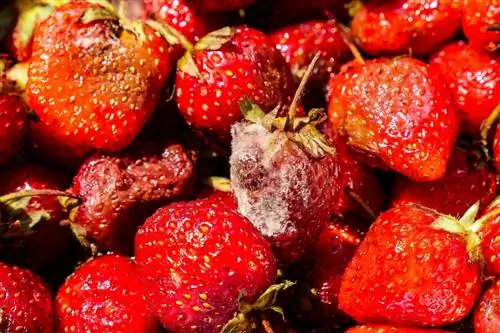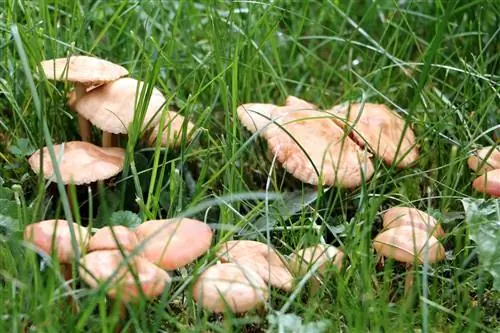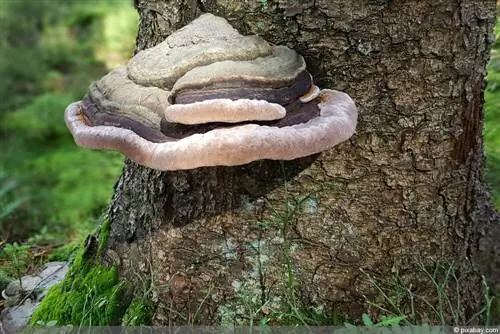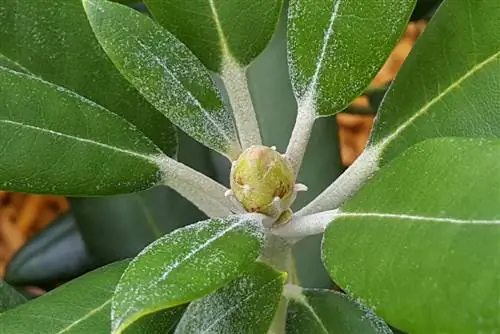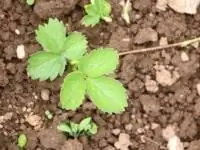- Author admin [email protected].
- Public 2023-12-17 03:39.
- Last modified 2025-01-24 12:45.
The dreaded gray mold fungus (Botrytis cinerea), also known as Botrytis fruit rot, is particularly common on crops. He doesn't spare strawberries either. If the infestation level is high, almost the entire crop can be affected. The main remedy in the hobby garden is preventative measures.
Preventive protection against gray mold on strawberries
- When planting a new strawberry bed, pay attention to a sunny, protected location
- Maintain planting distances (at least 60 x 30 cm)
- Weeding regularly
- Place plants with straw or wood wool before they bloom
- Water between plants when watering
- Selecting varieties that bloom above the foliage
- Planting the plant on a hill bed with mulch film
- Economical nitrogen fertilization
If gray mold infestation has occurred, the following measures must be taken:
- Removal of the affected fruits, disposal with residual waste
- Carefully clear dead plant parts from the bed in autumn, residual waste disposal
Biology of the gray mold pathogen
The spores of the pathogen, which is a mold fungus, penetrate the strawberry flowers in spring. They initially cause brown spots on the developing fruits, which become soft and “rotten” over time. Soon afterwards the fungus covers the fruit with its gray mold. This in turn forms spores that are released into the environment and can lead to new infections under appropriate weather conditions.
The infestation with gray mold makes the strawberries inedible; even fruits with only small areas of infestation should no longer be eaten or processed.
How preventive measures work
Botrytis cinerea requires a moist environment to develop and reproduce. Dry conditions do not suit him. However, planting the strawberry bed in a sunny location, strictly adhering to the usual planting distances for strawberries and regular weeding ensure that the strawberry leaves dry quickly after the morning dew or after rain. Placing the plants with wood wool or straw allows the flowers, which are usually slightly overhanging, and later the fruits to rest on dry ground and thus reduces the possibility of gray mold infestation.
Over the years, strawberry varieties have been bred whose flowers are above the foliage, meaning they can dry out quickly due to wind and sun. A trial with such a variety (e.g. “Tenira”) can be worthwhile for the hobby gardener.
Another possible option for preventing gray mold infestation on strawberries is the so-called hill bed, which can also be provided with black mulching film. This film is only made with the cuts necessary for planting. Rainfall can run off quickly from the planted hill bed; thanks to the elevated position, the wind quickly dries the strawberry plants that have been wetted by rainfall.
Since nitrogen promotes the formation of green leaf mass, this nutrient should only be fertilized sparingly. The result of abundant nitrogen fertilization would be dense, leafy strawberry plants that would create a moist microclimate inside that is suitable for gray mold fungus.
If gray mold infestation has already occurred, the affected fruits must be removed regularly, as they can cause infestation again. These fruits should not end up in the compost heap, as the fungus can continue to develop in them and “start” further infections from there. Disposal with residual waste is appropriate here. Botrytis cinerea overwinters in dead plant parts. After harvesting, all plant remains must be cleared from the bed. These residues should not be disposed of in the compost, but in the residual waste bin.
Pest Control Measures
If the hobby gardener doesn't want to miss out on his strawberry harvest even in very wet years, the use of fungicides is also possible in the home and allotment garden. Appropriate sprays are available from specialist retailers. However, the manufacturer's instructions must be observed when using them. In particular, the specifications regarding the time of application, the concentration to be used and the waiting period (time period from the last treatment until the fruit is edible) must be strictly adhered to.
Grey mold on other plants
However, there is also a downside, because gray mold also affects ripe grapes, which is an advantage. Why? Because the fungus punctures the berry skin and thus improves its water permeability. This in turn means that water evaporates more easily, while the remaining ingredients of the grape remain. The result is that not only the concentration of sugar in the grape increases, but also the concentration of the grape's characteristic flavors and aromas. This leads to a significant increase in the quality of the wine. In such a case it is referred to as so-called noble rot, because the mold is put to good use.
In this way, gray mold is of great importance not only in Germany for certain types of wine, but also in other European countries, for example in France, Austria or Hungary.
In other horticulture and agriculture, gray mold is more likely to cause damage by weakening affected crops. For example, chrysanthemums, strawberries and daffodils are affected.
The signs of infestation are different. They range from rotting tubers and visible gray fungal turf to rotten flower bases and mouse-gray looking fruits to speckled flowers.
Of course you can also do something against the infestation of gray mold; specialist retailers have special chemical products available. It is best to seek advice from a gardener to find out the right countermeasures.
Important for wine growing: gray mold
However, there is also a downside, because gray mold also affects ripe grapes, which is an advantage. Why? Because the fungus “perforates” the berry skin and thus improves its water permeability. This in turn means that water evaporates more easily, while the remaining ingredients of the grape remain. The result is that not only the concentration of sugar in the grape increases, but also the concentration of the grape's characteristic flavors and aromas. This leads to a significant increase in the quality of the wine. In such a case it is referred to as so-called noble rot, because the mold is put to good use.
In this way, gray mold is of great importance not only in Germany for certain types of wine, but also in other European countries, for example in France, Austria or Hungary.
Disadvantages for Agriculture & Horticulture
- In other horticulture and agriculture, gray mold is more likely to cause damage by weakening affected crops. For example, chrysanthemums, strawberries and daffodils are affected.
- The signs of infestation are different. They range from rotting tubers and visible gray fungal turf to rotten flower bases and mouse-gray looking fruits to speckled flowers.
- Of course you can also do something against grapevine disease; specialist retailers have special chemical agents against gray mold available. It is best to seek advice from a gardener to find out the right countermeasures.

